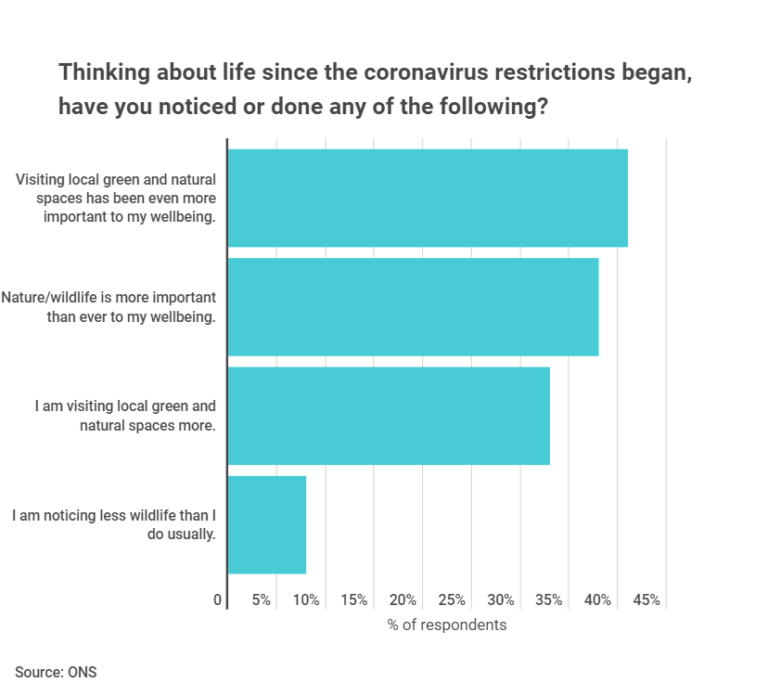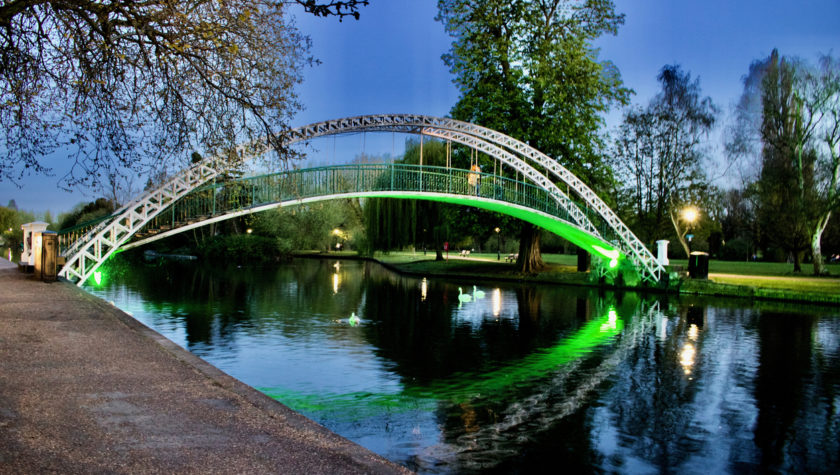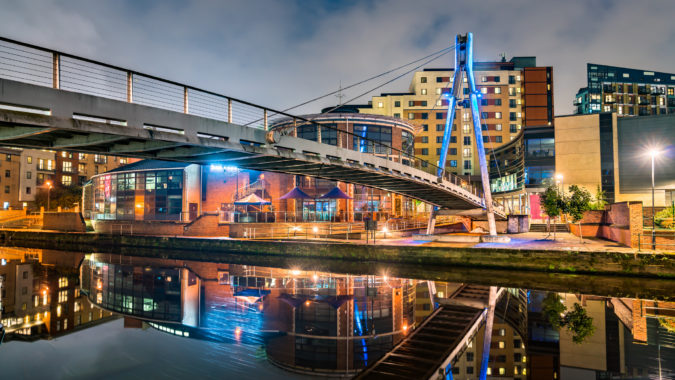An opinion piece by Ann Zhang, economist at Frontier Economics and Chair of the Commission’s Young Professionals Panel.
A Breath of fresh air: Green space and mental health
If there is one lesson that lockdown has taught me, (aside from the fact I will never be a star baker), it is that access to green space is key to mental wellbeing. This past year has tested our mental resilience and like many others, ‘pandemic burnout’ left me feeling anxious and struggling to get through the day. Spending time outdoors during our ‘daily exercise’ allowance was one of the few ways I could get out of my own head and regain a modicum of calm.
And I’m not the only one. 90 per cent of people agreed that natural spaces were good for mental health and wellbeing and 46 per cent of people are spending more time outdoors than before the pandemic.

This chart is accessible online.
Research has found that being outside is associated with greater happiness1, greater sense of safety,2 and can even help marginalized people to reintegrate with society.3 It also improves physical health, creating a virtuous cycle of wellbeing.
However, access to green spaces is not equal. One in eight people have no access to a private or shared garden, and 2.7 million people live more than a 10-minute walk from a public park. And like most inequalities, it is often people from low-income and BAME backgrounds who are losing out4.
Missed Connections: Making public transport easier to navigate
Increasing use of public transport is key to the Government’s 10 point plan for the Green Industrial Revolution. Its National Bus Strategy, published earlier this year, identified several barriers to delivering bus services, including limited co-operation between bus operators, lack of evening services, complex ticketing, and poor integration.
As part of the YPP Towns Study engagement, we spoke to young people living in Towns who shared their experience of public transport:
I never considered using public transport because of my anxiety and the feeling of lack of control.
Electronic timetables at bus stops would have been helpful. The way I deal with anxiety is planning for eventualities. If a bus that normally comes at 2pm isn’t there, it would be helpful to see that you haven’t missed it, it’s just delayed.
That’s very helpful for somebody suffering like that. I wouldn’t have to worry about what I need to do if I have missed the bus, like telling people I’ll be late or changing plans. Any and all information would make it easier.
There is no doubt that addressing these issues will improve bus services. However, people with mental health problems can face additional barriers to using public transport. Research carried out by the Future of Transport found that any increase in time, cost, potential for delays, number of changes, and level of crowding increases the likelihood of travelling by car rather than public transport, and the effect was much stronger than amongst people without anxiety or depression.5
Even small changes can help to make public transport easier to navigate for people with mental health problems. Installing digital timetables at bus stops can provide valuable information to people suffering from anxiety, allowing them to plan in the event of delays or missed connections, and provide them with the confidence required to travel alone. TfL has published maps that mark out routes with tunnels, allowing people with claustrophobia and other conditions to plan their journeys in advance to avoid these routes. Inclusive design for public transport is key to ensuring that public transport really does serve all members of the public. This in turn will increase social inclusion and support levelling up, allowing more people to travel to jobs and see friends and family, all whilst delivering on the green revolution.
YPP member Caroline Bryce shares her experience of public transport:
Whilst many accept crowded trains as the norm for city commuters, for others like myself it can be the most stressful part of the day. When a train is cancelled, for many it is frustrating, but for me it spikes a fear of how busy the next service will be and will I have to skip it and wait for next one. This was ok when I lived in Newcastle and the next metro was in 11mins, but now living in the outskirts of Leeds the next train could be a half an hour wait.
I’m lucky that my employer has flexible working hours and I used to start earlier to finish earlier so I could avoid the peaks on the trains. But if I was delayed at work I’d often wait around later until after rush hour to make my commute home. This then meant walking the final mile in the dark when it was much quieter.
Building back better: intentional design
These examples offer only a small snapshot into the ways infrastructure interacts with mental health. The 2021 National Infrastructure and Construction pipeline sets out almost £650bn of infrastructure investment between now and 2030/31. These projects will affect almost everything we interact with on a daily basis including transport, energy, digital infrastructure, and social infrastructure. At the same time, one in six people experience a common mental health issue in any given week. To ensure that we truly are ‘building back better’, the YPP recommends that:
- Green infrastructure should be considered of equal importance to other types of social and economic infrastructure. Much of this will in practice be best delivered at a local level, and the YPP supports the NIC’s recent recommendation on devolving five year transport budgets to local authorities to support local growth strategies, which should explicitly embrace the development of green spaces. In the meantime, we think the current approach in the Levelling Up Fund, which allows local authorities to bid for money for parks and green spaces, should be extended to other pots of money designated for ‘levelling up’. For large scale projects, extending the scope of Nationally Significant Infrastructure Projects to include green space would be beneficial.
- Whilst the Green Book encourages projects to consider wider societal outcomes when calculating benefits, and steps are being taken in the right direction with the introduction of new guidance focused on wellbeing, more needs to be done to move evaluation away from the traditional ‘cash-releasing’ benefits and fully account for harder to monetise impacts such as health improvements
- The commitments in the NIS to ‘good design’, including a board level design champion on all infrastructure projects, should consider the needs of specific user groups as part of the ‘people’ design principle.
- Public consultation and targeted engagement with under-represented groups should be ‘business as usual’. This extends beyond mental health advocacy groups and includes targeted engagement for BAME communities, women, LGBT+, and any other groups whose needs are less likely to be accounted for in the current planning process, either due to a lack of understanding of their individual needs, or lack of representation among decision-makers. Greater diversity amongst decision-makers will also ensure that infrastructure provision and design meets the needs of the whole community.
Recognising the relationship between infrastructure and mental health, and designing with this in mind, allows us to build a world that can safely be used and enjoyed by all.





